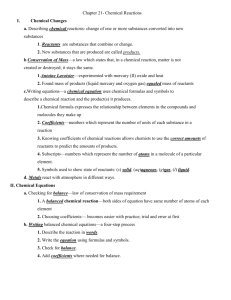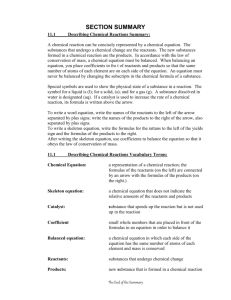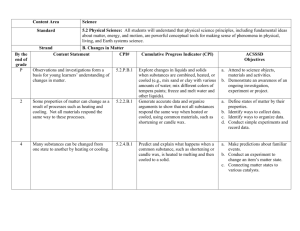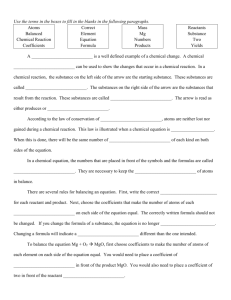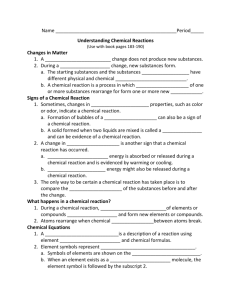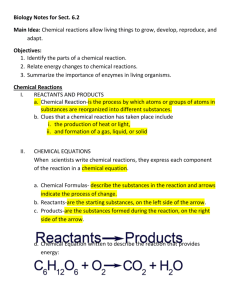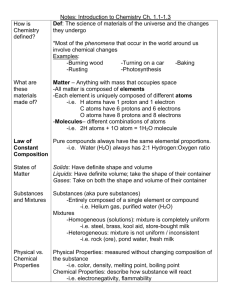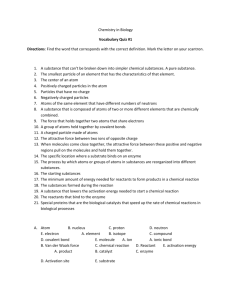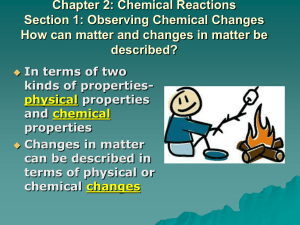Ch. 19 Notes
advertisement
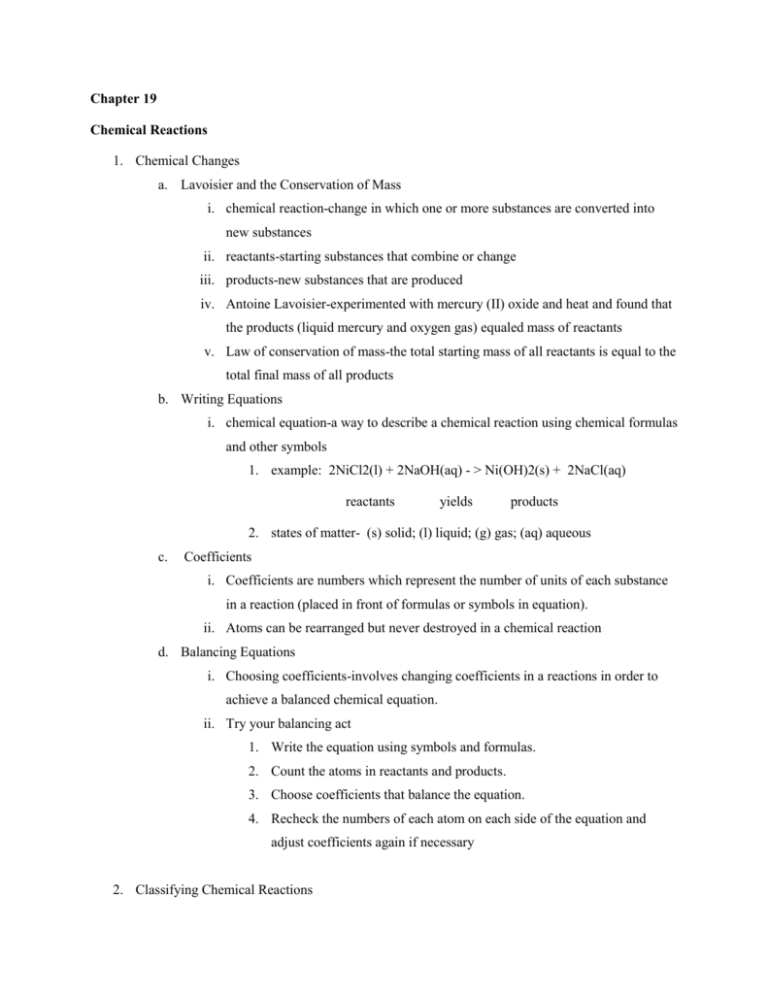
Chapter 19 Chemical Reactions 1. Chemical Changes a. Lavoisier and the Conservation of Mass i. chemical reaction-change in which one or more substances are converted into new substances ii. reactants-starting substances that combine or change iii. products-new substances that are produced iv. Antoine Lavoisier-experimented with mercury (II) oxide and heat and found that the products (liquid mercury and oxygen gas) equaled mass of reactants v. Law of conservation of mass-the total starting mass of all reactants is equal to the total final mass of all products b. Writing Equations i. chemical equation-a way to describe a chemical reaction using chemical formulas and other symbols 1. example: 2NiCl2(l) + 2NaOH(aq) - > Ni(OH)2(s) + 2NaCl(aq) reactants yields products 2. states of matter- (s) solid; (l) liquid; (g) gas; (aq) aqueous c. Coefficients i. Coefficients are numbers which represent the number of units of each substance in a reaction (placed in front of formulas or symbols in equation). ii. Atoms can be rearranged but never destroyed in a chemical reaction d. Balancing Equations i. Choosing coefficients-involves changing coefficients in a reactions in order to achieve a balanced chemical equation. ii. Try your balancing act 1. Write the equation using symbols and formulas. 2. Count the atoms in reactants and products. 3. Choose coefficients that balance the equation. 4. Recheck the numbers of each atom on each side of the equation and adjust coefficients again if necessary 2. Classifying Chemical Reactions a. Types of Reactions i. Combustion reaction-a substance reacts with oxygen to form heat and light. ii. Synthesis reaction-two or more combine to form another substance: 1. A +B -> C 2. H2(g) + Cl2(g) -> 2HCl(g) iii. Decomposition reaction -one substance breaks down into two or more 1. substances: AB->A+B 2. 2H2O2(l) -> O2(g) + 2H2O(l) iv. Single-displacement reaction-one element replaces another one in a compound: 1. A + BC -> AC + B 2. Cu(s) + 2AgNO3(aq) -> Cu(NO3)2(aq) + 2Ag(s) v. Double-displacement reaction-results if a precipitate, water, or gas forms when two ionic compounds in solution are combined. 1. AB+ CD -> AD + CB 2. 2NaOH(aq) + CuCl2(aq) -> Cu(OH)2(s) + 2NaCl(aq) 3. Chemical Reactions and Energy a. Chemical reactions - energy exchanges b. Breaking chemical bonds requires energy c. Forming chemical bonds releases energy d. Exothermic reaction-energy is given off in the form of thermal energy e. Endothermic reaction-energy is required in the form of thermal energy 4. Reaction Rates and Equilibrium a. Reaction rate- the rate at which reactants change into products b. Factors affecting reaction rates (collision model states that atoms, ions, and molecules must collide in order to react) i. Increasing Temperature ii. Increase Concentration iii. Increasing Surface Area iv. Adding a catalyst-speeds up a chemical reaction without being permanently changed v. inhibitor-prevents or slows down a chemical reaction Chapter 19 Vocabulary Balanced chemical equation - Chemical equation with the same number of atoms of each element on both sides of the equation Catalyst - Substance that speeds up a chemical reaction without being permanently changed itself Chemical equation - Shorthand method used to describe chemical reactions using chemical formulas and other symbols Chemical reaction - Process in which one or more substances are changed into new substances Coefficient - Number in a chemical equation that represents the number of units of each substance taking part in a chemical reaction Collision model - Explains why certain factors affect reaction rates, states that particles must collide in order to react Combustion reaction - A type of chemical reaction that occurs when a substance reacts with oxygen to produce energy in the form of heat and light Decomposition reaction - Chemical reaction in which one substance breaks down into two or more substances Double-displacement reaction - Reaction in which two ionic compounds in solution are combined, can produce a precipitate, water, or a gas Endothermic reaction - Chemical reaction that requires thermal energy in order to proceed Equilibrium - State in which forward and reverse reactions or processes occur at equal rates Exothermic reaction - Chemical reaction in which energy is primarily given off in the form of thermal energy Inhibitor - Substance that slows down a chemical reaction or prevents it from occurring by combining with a reactant Le Hotelier’s principle -States that if a stress is applied to a reaction at equilibrium, the reaction shifts in the direction opposite of the stress Molar mass - The mass in grams of one mole of a substance Mole - SI unit for quantity equal to 6.022 × 10^23 units of that substance Oxidation -The loss of electrons from the atoms of a substance in a chemical reaction Precipitate - Insoluble compound that is formed in a solution during a double-displacement reaction Product - In a chemical reaction, the new substance or substances formed Reactant - In a chemical reaction, the substance that reacts Reaction rate - The rate at which reactants change into products in a chemical reaction Reduction - The gain of electrons by the atoms of a substance in a chemical reaction Reversible reaction - A reaction that can proceed in both the forward and the reverse directions Single-displacement reaction - Chemical reaction in which one element replaces another element in a compound Synthesis reaction - Chemical reaction in which two or more substances combine to form a different substance

